
The Bo-Kaap (old Malay Quarter) was declared an exclusive residential area for the Muslim Cape Malays under the apartheid era's Group Areas Act of 1950, forcing people of other religions and ethnicity to leave. The term 'Cape Malay' was originally used to describe the slaves from Malaysia, Indonesia, and various African countries who were imported to the Cape of Good Hope by the Dutch during the 16th and 17th centuries (rather than just to describe Malaysian slaves). Today, the area is still closely associated with the Muslim community and has a distinct and vibrant character. The houses have been restored and colourfully painted. The steep cobbled streets, mosques, minarets, and blend of Cape Dutch and Edwardian architecture also contribute to making it one of the city's most interesting cultural and historical areas. The Bo-Kaap Museum on Wale Street documents the history of the Cape Malays and is worth a visit for those wanting a more in-depth understanding of the area.There are also some fun and interesting walking tours available. The Bo-Kaap is a great favourite with photographers and its charm ensures that it is the frequent subject of Cape Town postcards.
Address : Museum: 71 Wale Street, Bo-Kaap, Cape Town
Website : www.iziko.org.za/museums/bo-kaap-museum

Most Cape Town visitors are keen to make the short, 40 mile (65km) daytrip from the city centre to the Cape of Good Hope Nature Reserve. The land at first appears bleak, but visitors will soon discover a region rich in floral diversity. They will also stand atop the towering promontory at the most southerly point of the Cape Peninsula. Those who wish to venture to the most southerly point of Africa will have to journey further to Cape Agulhas. Visitors can reach the viewpoint and lighthouse via a funicular, and watch thundering waves crash at the base of the cliffs below. Bird lovers and botany enthusiasts will enjoy exploring the reserve itself. There are a number of beautiful walking trails, including the shipwreck trail, which takes visitors to a few of the 26 recorded shipwrecks around Cape Point. There are also some great beaches and dive sites. The restaurant at Cape Point has a terrace offering spectacular views.
Website : www.capepoint.co.za

Cape Town has some truly gorgeous beaches, but the most glamorous are on the Atlantic Ocean, where the water is unbelievably cold. Even the locals tend to keep their swims short. The most popular choices include Camps Bay Beach. Locals and tourists pack its long, wide stretch of silver sand and enjoy the trendy bars and restaurants nearby. Another favourite is Clifton, where four beaches are situated beneath the exclusive houses and apartments set into the cliff. The beaches are named First, Second, Third and Fourth Beach. First Beach is the largest and most popular among families, while Second Beach is preferred by the hip crowd. Third and Fourth Beach are usually frequented by locals. The small suburb of Llandudno lies 15 minutes south of Camps Bay, and is home to one of the most scenic beaches in South Africa. It's popular for sundowners on the rocks or long days in the sun.Despite its popularity, Llandudno is seldom too crowded. This is partly because there are no bars or restaurants there. The nearest is in Hout Bay, which is another 10 minutes south. Hout Bay's long beach is popular with families and walkers but is not as stunning as its neighbours. False Bay is also blessed with lovely beaches and these tend to be more family-friendly and less trendy. The most popular beach for beginner surfers in Cape Town is Muizenberg, which has plenty of surf schools. The Muizenberg and Fish Hoek beaches of False Bay are also wonderful for swimming, as the water in False Bay is much warmer than on the Atlantic side. For long walks and horse riding, the lovely Noordhoek beach is ideal.To see Cape Town's penguin colony, tourists should visit the picturesque Boulders Beach in Simonstown, where the loveable birds suntan and swim. Sharks are a problem in Cape Town, particularly in False Bay, and many beaches have shark spotters on duty. Visitors should pay close attention to the flags on the beach, as they signal whether it is safe to swim. A siren will go off to warn swimmers in the water if a shark is spotted nearby.

For fun encounters with one of South Africa's oddest and most unique animals, the Cape Town Ostrich Ranch is a great bet. The ranch is a good family attraction, but having kids along is not necessary to enjoy the experience. Although it is possible to explore the ranch independently, most people choose to join one of the organised tours, which are conducted in English, Afrikaans, German, and French. Tours in other languages may be possible if organised in advance. Tours take about 40 minutes and include the museum, the leather factory, and encounters with the various ostriches and other animals on the farm. The highlight for many visitors is the chance to sit astride an ostrich for a photo opportunity with the iconic Table Mountain in the distance. Those wanting to feed the ostriches will be able to buy feed at the ranch. The restaurant serves up a variety of snacks and meals in a lovely Cape Dutch garden setting, while the shop sells all sorts of ostrich products. A playground and sand pit provide extra entertainment for kids. Children will also love the scratch patch, where they can select a variety of sparkly gemstones.
Address : Van Schoorsdrif Road, Philadelphia, Cape Town
Website : www.ostrichranch.co.za
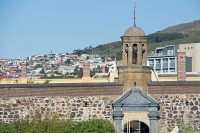
South Africa's oldest surviving colonial building, the Castle of Good Hope was completed in 1679. It replaced an earlier mud and timber fort built by the first Dutch Governor, Jan van Riebeeck. Situated adjacent to a parking lot and bus station in Buitenkant Street, its walls mark the original boundary of the seashore where the waves washed up against the fortifications. Its outside aspect is somewhat foreboding, but inside are some interesting features and collections that have been restored, offering a good insight into the early days of the Cape, when the castle was the centre of social and economic life. The complex is a pentagonal fortification with a moat and five bastions, each named for one of the titles of the Prince of Orange. The entrance is a good example of 17th-century Dutch Classicism, and a bell, cast in 1679 by Claude Fremy in Amsterdam, still hangs from the original wood beams in the tower above the entrance.The castle contains a Military Museum depicting the conflicts that arose during the Cape's early settlement, and also houses the William Fehr Collection of decorative arts, including paintings, furniture, and porcelain. Of interest are the dungeons, which bear carvings in the walls by prisoners incarcerated centuries ago. The castle was built for defence, not beauty, and it is a fortress not a palace. Those interested in the history of the Cape will find a visit fascinating.
Address : Buitenkant Street, opposite the Grand Parade
Website : www.castleofgoodhope.co.za
Opening times : Daily 9am to 4pm.
Admission : R30 (adults), R15 (children and students). Other concessions available.

Chapman's Peak Drive is one of the most spectacular coastal roads in South Africa and the world. It links the seaside community of Hout Bay to the Noordhoek Valley along the Atlantic Coast, and offers breath-taking views from along the narrow, winding road blasted into the cliffs. Started in 1915, the six-mile (9km) route took about seven years to complete and was built as a shorter, alternative route between Cape Town central and the South Peninsula. Many visitors use this scenic route to reach Cape Point Nature Reserve, situated at the tip of the Peninsula. But for many Capetonians, it simply comprises a breathtakingly beautiful commute to work. There are a number of gorgeous picnic sites and viewpoints along the route and it is very popular with cyclists. Chapman's Peak Drive is also the ideal vantage point for whale watching, the peak whale season being mid-August to mid-November. Hiking up Chapman's Peak and through Silvermine Nature Reserve and the Cape Peninsula National Park offers spectacular views over the South Peninsula.With sheer cliffs below, soaring mountains above, and the ocean stretching to the horizon, this dramatic stretch of road is a must-see for tourists in Cape Town.
Website : www.chapmanspeakdrive.co.za
Opening times : Open 24 hours; the road closes occasionally due to heavy rainfall, or rockfalls
Admission : Chapmans Peak Drive is operated as a toll-road. Light motor vehicles cost about ZAR 45.

Until the 1960s, District Six was a vibrant district of Cape Town located close to the city centre and the harbour. The community was originally established as a mix of freed slaves, merchants, artisans and immigrants, and developed a unique multiracial character. In 1966, the government declared District Six a 'whites only' area under the Group Areas Act and over 60,000 residents were forcibly moved to the outlying Cape Flats, a barren area several kilometres away, while most of their homes were flattened by bulldozers. Communities and families were uprooted and torn apart, and this moving museum serves to safeguard the memories and the spirit that was District Six. The venue was originally established as a place where ex-residents could meet and support one another, but is now a fascinating little museum. It houses an impressive collection of old materials, including photographs and relics such as street signs, many of which were donated by former residents.The museum also offers a guided tour of the area led by an ex-resident. It is a poignant way to learn about District Six as it used to be. These tours must be booked in advance via the official website listed below. It is also possible to wander into the museum off the street and take a self-guided tour.
Address : 25A Buitenkant Street
Website : www.districtsix.co.za
Telephone : 021 466 7200
Opening times : 9am to 4pm Monday to Saturday. Sundays by appointment only.
Admission : R30 (adults), R5 (children).
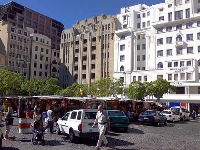
Situated near the main train station in the Central Business District, Greenmarket Square is the perfect spot to observe South Africa's diverse population in all its hues and voices. Once the scene of slave markets, it now accommodates one of the city's most vibrant flea markets, where clothing, jewellery, trinkets, and souvenirs are on sale most days. Tourists and business people rub shoulders in the many sidewalk cafés that surround the busy cobbled square. Visitors should be prepared to haggle for the best prices at the market, and should be aware that touts are prevalent. Rain doesn't generally deter vendors, with most covering their stalls with tarpaulins in bad weather. Stalls generally start clearing up for the day in the late afternoon, though seldom before 3pm. The market does not operate on Sundays. There are many other great attractions in the area, including several art galleries and museums. For instance, the Old Town House lies on the west side of Greenmarket Square. Dating from the mid -18th century, it is a wonderful example of Cape Dutch architecture and houses the Michaelis collection of Dutch and Flemish landscape paintings.

Locals and international tourists alike travel south of Cape Town to Hermanus. The charming seaside town is about a two-hour drive outside the Mother City, and is known for its whale watching, as Southern Right Whales migrate through the area to nearby Walker Bay. Visitors are almost guaranteed a sighting of these gentle giants from the steep cliffs of Hermanus between September and October, and the Two Oceans Whale Festival draws big crowds over this period. There are also opportunities to view other wildlife, including dolphins, seals, penguins, and Great White Sharks. The town itself offers many other activities. These include browsing shops and restaurants in the quaint downtown area to venturing further afield to wine farms and beaches and neighbouring towns like Stanford, Gansbaai, and Caledon. Active pursuits include horseback riding, quad biking, hiking, sandboarding, mountain biking, kayaking, and zip lining. Strolling along the cliff walk in Hermanus is a must for visitors, even if there are no whales in the bay. Book fanatics should seek out the wonderful second-hand book store in Hermanus called Hemingways.
Website : www.hermanus.co.za

The magnificent Kirstenbosch National Botanical Gardens lie just south of the city centre and cover a huge expanse of the rugged southwestern slopes of the Table Mountain Range. Kirstenbosch was bequeathed to the nation by mining magnate Cecil Rhodes in 1895, and today contains a nursery, a research unit, a botanical library and more than 22,000 plants. Numerous paths meander through the gardens, including a Braille route for the blind. Nature lovers should note that the walks are full of lush shrubs and fynbos, the Cape's indigenous floral heritage. The gardens are indeed a natural wonderland, where visitors will find lots of space for picnics. Several incredible hikes can be started from the gardens, including the formidable Skeleton Gorge, and Nursery Ravine, which wind steeply up the mountain and generally take between four and six hours. If these difficult hikes sound a little frightening, some far gentler and shorter trails wind through the gardens. Visitors will find a tea room, two restaurants, and a coffee bar on site.In summertime, the delightful setting becomes the venue for Sunday evening open-air concerts, when picnickers relax on the lawns, sipping wine, and enjoying the sunset entertainment. There are also outdoor movie screenings in summer.
Address : Rhodes Drive, Newlands
Website : www.sanbi.org/gardens/kirstenbosch
Opening times : Daily 8am to 6pm (April to August); 8am to 7pm (September to March); Conservatory 9am to 5pm
Admission : R60 (adults), R15 (children 6-18). Concessions available. Concert fees are applicable on Sunday afternoons during the Summer Sunset Concert series
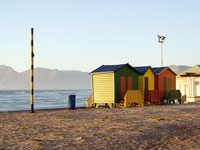
A historical beach-side suburb on the False Bay coast, Muizenberg is popular with families for its long beach, warm water (by Cape Town standards), beautiful views, and activities such as mini-golf and waterslides. The beach is famous for its row of colourful changing houses and is a photo favourite from the mountain road far above. Muizenberg beach has also long been the best place in Cape Town for beginner surfers to learn and enjoy the waves. Its break is far less daunting and competitive than Cape Town's other surf spots. Several popular surf schools have been established at Surfers Corner in Muizenberg, accompanied by a few fun cafés and restaurants. False Bay is also known for its Great White Shark population, but a shark watch service is in operation to give warning to bathers and surfers. Visitors should take note of the flag and siren system which is clearly explained on signposts.A scenic walkway below the railway line links Muizenberg to the next seaside village of St James and its lovely tidal pool. The delightful fishing village of Kalk Bay is a few minutes' drive away, with its protected harbour and its main street lined with fascinating antique and art shops, as well as coffee shops, eateries and bars.
Website : www.muizenberg.info
Transport : The train line between Cape Towns centre and Simonstown runs through Muizenberg.

Robben Island is seven miles (11km) from Cape Town, and is easily seen from the shore. For nearly 400 years, this tiny rocky island was utilised as a place of banishment, exile, isolation, and imprisonment for numerous categories of people ostracised by society, ranging from political protesters to lepers. During the years of Apartheid, Robben Island became synonymous with institutional brutality as numerous freedom fighters, including the island's most famous resident, Nelson Mandela, were imprisoned here for more than a quarter of a century. Robben Island is now a museum, symbolising the liberation and triumph of the human spirit. Regular island tours are conducted and last for around three and a half hours. The tours are guided by former prisoners and include a visit to the maximum-security prison on the island, where an estimated 3,000 freedom fighters were incarcerated between 1962 and 1991. The island is also interesting in other ways. For instance, it is a magnet for shipwrecks, with at least 68 recorded cases across its rocky coastline.The boat trip across the bay can be really fun in itself, and some wonderful views of the city and Table Mountain are gained from the ferry ride and the island itself.
Website : www.robben-island.org.za
Transport : Boat from the Nelson Mandela Robben Island Gateway in the clock tower precinct at the Victoria and Alfred Waterfront in Cape Town. Book in advance
Opening times : Boats leave roughly every two hours between 9am and 3pm (weather dependent).
Admission : Tours are R300 (adults), R160 (children under 18), which includes the return boat trip across Table Bay.
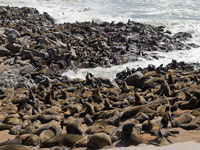
Seal Island visitors can glimpse of these wonderful animals at play and at rest. Although several tiny islands off the coast are unofficially part of Seal Island, the most well-known is Duiker Island. Located a small distance out from Hout Bay, boats regularly leave the docks and take passengers outside the harbour and into the ocean. From here, they can enjoy sweeping views of Hout Bay, Noordhoek, Kommetjie, and the famous Chapman's Peak. The boat stops just below the Hout Bay Sentinal, where hundreds of Cape fur seals bask on the small island in the sun. The sight is magical, if a bit pungent. Many of the boat tours use glass-bottomed vessels that allow sightings of the seals zipping about beneath the water. The charming naval harbour of Simon's Town has a colony too, with tours also leaving its shores. The great white sharks that frequent the False Bay region often lurk hungrily around the islands. Sightings of these awesome apex predators are possible, albeit rare. There are excursions that specialise in spotting the act of breaching, whereby the sharks propel themselves out of the water on catching their prey.
Address : Hout Bay Harbour or Simons Town Harbour.
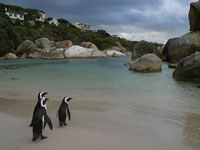
Simonstown is South Africa's principal naval base and lies about 25 miles (40km) from the city centre. The quaint suburb was built around a naval dockyard, and visitors will enjoy its well-preserved Victorian buildings, museums, sidewalk cafés, and local heroes. One such hero was a dog called 'Just Nuisance', who joined the British navy, becoming their mascot, when Simonstown was a British base. A statue of the beloved Great Dane can still be seen on the beachfront. A short distance from the town is Boulders Beach, famous for its protected colony of African Penguins. People watch the animals while on the beach as well as from viewing platforms. The penguins are remarkably tame, meaning visitors can get very close to take photographs, even though they shouldn't try to touch the animals. The loveable birds continue to swim and frolic beneath the waves, totally unperturbed. The beach is truly beautiful at Boulders, with turquoise water and, as the name suggests, picturesque rock formations. It's worth a visit in any season just to see the penguins, and kids will love it.
The imposing South African Museum is dedicated to natural history and the human sciences, and contains a huge variety of fascinating exhibits. Among other things, visitors will encounter entire chunks of caves bearing rock art, and traditional arts and crafts from several African tribes. Astoundingly, the museum houses more than one and a half million specimens of scientific importance, including fossils that are almost 700 million years old. The vastness of the collection means that for every object on display, thousands more are kept in storage. The natural history exhibits are full of mounted mammals, dioramas of prehistoric reptiles, and a collection of whale skeletons, with haunting whale song echoing in the background. Established in 1825, the South African Museum is still very old-fashioned in some ways. Nevertheless, it is well worth a visit for its impressive collection. Alongside the museum is the Planetarium, which has a changing programme of thematic shows involving the southern constellations. Booking ahead is necessary for Planetarium shows.These two attractions are based in the lovely Company Gardens of Cape Town, which are also worth exploring.
Address : 25 Queen Victoria Street, Gardens
Website : www.iziko.org.za
Opening times : Daily 10am to 5pm (museum).
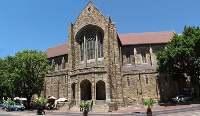
Founded in 1901 and situated on Wale Street, Cape Town's Victorian Gothic style Anglican Cathedral is historically significant for hosting the enthronement of South Africa's first black archbishop, Nobel Peace Prize winner Desmond Tutu. The Cathedral is unique in that it became a political powerhouse in the struggle against Apartheid. Known as 'the people's cathedral', it began openly welcoming people of all races in the 1950s. This was a brave stand in the racially segregated society of the time. In subsequent years, the cathedral became the venue for many protest gatherings and vigils and, on occasion, the building was surrounded by police, water cannons, and barbed wire. Victims of forced removals were even accommodated in the cathedral at times. As far as architectural merit goes, the cathedral does feature some fine Gabriel Loire windows, including a magnificent Rose Window above the south transept. It is an imposing church, well integrated into the community and well cared for, and the profoundly inspirational legacy of Desmond Tutu is palpable.
Address : Wale Street

Cape Town's most popular tourist attraction is also its most famous physical feature. The flat-topped mountain stands as a sentinel over the city, and has been proclaimed a nature reserve, thereby protecting its diverse floral species. Some are unique to its slopes. The views of the city and coastline from the top of the mountain are quite spectacular in all directions. A Swiss-built rotating cable car carries visitors smoothly up the mountain and back. The mountaintop is equipped with a restaurant and small gift shop, as well as numerous pathways and vantage points. It is possible to climb the mountain via different routes, but inexperienced hikers should take care because Cape Town is prone to sudden weather changes. The walk up can take a few hours, depending on the route and level of fitness. Route maps can be bought at the cable-car station. It is always best to check the website or call the weatherline to see if the cable car is in operation. Hikers should travel in groups, as there have been reports of robberies on the trails.Tickets for the cable car can be booked online via the official website. They are marginally cheaper online and allow travellers to skip the sometimes long queues at the ticket kiosk. Ascending Table Mountain is an absolute must for visitors to Cape Town.
Address : Tafelberg Road
Website : www.tablemountain.net
Transport : Bus to Kloof Nek from Adderley Street and a 1.5km walk up the hill; minibus taxi from the Parade; Riki taxi; or as part of the Cape Town Hop-On Hop-Off bus tour
Opening times : Cable car operates daily (weather permitting) every 10-15 minutes from 8am to 8pm (November); 8am to 10pm (December to January); 8am to 8:30pm (February); 8am to 7:30pm (March); 8am to 6:30pm (April); 8:30am to 6pm (May to mid-September); 8:30am to 7pm (16 September to October). Closed for annual maintenance for about three weeks in July and August
Admission : Cable car: R225 return, R135 one way (adults); R125 return, R65 one way (children under 18). Other concessions available.
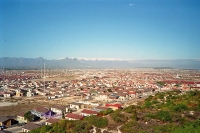
The N2 highway that connects Cape Town International Airport to the city is lined with townships, which consist of a mixture of shacks and solid buildings. During the days of apartheid, people of colour were not allowed to live in the white suburbs and were relocated to areas away from the city. These tours allow visitors to experience how the majority of Capetonians still live. Guides, often residents, take visitors around to meet the people, see community projects, have a drink in a shebeen (township pub) and shop for local crafts. Each township has its own colourful character, and despite their difficult living conditions, residents are generally friendly and hospitable. Townships were once no-go areas for many people but, today, visits are becoming popular among tourists to Cape Town. Visitors are advised not to visit the townships alone as crime is still rife and some areas are best avoided completely. There are many tour companies that offer wonderful trips, including transport to and from the township areas.There is the possibility that these tours can become unpleasantly voyeuristic in the wrong hands. Tourists should remember that they are exploring real communities where people live and should treat the locals with respect.
Telephone : Cape Town Tourism Visitor Information Centre: 021 487 6800, or Sivuyile Tourism Centre: 021 637 8449

The Cape sits at the meeting place of the Atlantic and Indian Oceans, and over 3,000 sea animals from both oceans are showcased in the aquarium. They highlight the diversity of marine life found in the waters around Cape Town. The Two Oceans Aquarium is one of the city's top attractions and visitors of all ages will be interested in the variety of exhibits. They include the Predator Exhibit, which features large sharks and rays, and the mesmerising Kelp Forest Exhibit. Animals such as seals, penguins and turtles, and thousands of different fish are on display too. It is also possible embark on dives in specific tanks. Advanced booking is required, divers must present dive qualifications, and the privilege does carry an additional charge. The Shoreline Cafe at the Aquarium boasts lovely views of Table Mountain and the harbour, and has a children's play area, making it an ideal place to have refreshments. However, visitors are spoilt for choice because the aquarium is located at the famous V & A Waterfront, which is crammed full of great restaurants.It is special to be able to stroll along the harbour after visiting the aquarium, and boat trips out into the open ocean can be arranged from there.
Address : V&A Waterfront
Website : www.aquarium.co.za
Opening times : Daily 9:30am to 6pm
Admission : R160 (adults), R115 (children 14-17), R75 (children 4-13). Tickets valid for the day.

This working harbour, historical site, and shopping development has become one of Cape Town's most visited tourist attractions. The Waterfront offers everything from shopping malls and crafts markets, to live music and a variety of festivals throughout the year. It's also home to more than 70 eateries, ranging from pubs and fast food outlets to five star restaurants. Those who fall in love with the Waterfront will be glad to know that there are several luxury hotels in the area. What's more, travellers can stroll down to the harbour to gaze upon the numerous boats and ships upon the waves. Those who want to experience the thrill of sailing out of the harbour into the open ocean can choose from a variety of boat trips and harbour cruises. Helicopter charters leave from the waterfront as well. These include sunset booze cruises, whale-watching trips, and even a pirate galley that throws themed outings. The Two Oceans Aquarium is an impressive and celebrated institution and houses an impressive array of life from the oceans surrounding the Cape Coast.The aquarium is a must for those travelling in Cape Town with kids, but adults will also find themselves entertained. The V & A Waterfront is situated in a beautiful and central location, all the while under the watchful guard of the iconic Table Mountain.
Website : www.waterfront.co.za
Transport : MyCiti buses service the V & A Waterfront.

Travel Guide powered by Word Travels, copyright © 2023 Globe Media Ltd. By its very nature information in this travel guide is subject to change at short notice and travellers are urged to verify information on which they're relying with the relevant authorities. Neither Globe Media Ltd nor Travel Vogue can accept any responsibility for any loss or inconvenience to any person as a result of information contained above.